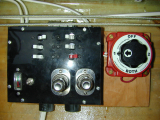 |
The main circuit box, showing circuit breakers, two of the cigarette lighters, and the switch for the batteries. |
Although the steamboat appeared old-fashioned, it contained some state-of-the art equipment.
For communications, we carried a VHF radio for contacting the lockmasters and had a cell phone for business calls and possible emergencies.
I recorded daily notes of the trip on a laptopcomputer. I used a digital camera for taking photographs. The photographs were stored on a 48 megabyte compact flashcard. Each evening, I would download these onto the computer. I had rechargeable batteries for the camera, a battery recharger, and a stock of spare alkaline batteries. We also carried a Zip drive and some Zip discs on which to make backup copies of the photographs.
We had cigarette lighter adapters for the VHF radio, the cell phone and the laptop. We also had a halogen light that would plug into the cigarette lighter. We carried two lawn tractor batteries that we could switch between. We had a battery recharger for these batteries. Circuit breakers included ones for the bilge pump, bow or stern cigarette lighters, navigation lights, and a spare.
I used binoculars frequently for reading the numbers on daymarks and
buoys and for observing great blue herons and other birds.
|
|
. .